The following is a guest blog written by Stephanie Hubka of ProtosLearning.com
The room was pitch black; my flashlight had mysteriously turned off when I needed it the most. From behind me, a voice growled, “You’ll never get out in time.” I rolled my eyes and fumbled toward the doorway, aware of how my heart had settled into a steady, measured rhythm. “That’s what you think,” I muttered. Despite the dark, success was the only option I could see.
Far from my typical days as an instructional designer, I found myself voluntarily trapped in the home of a notorious butcher in a desperate attempt to confirm his identity before he struck again—and if he did, it could be at my expense. Partnered with two of my brilliant friends turned investigators, we had just 60 minutes to solve puzzle after puzzle, each one bringing us closer to the escape we desperately wanted.
As we entered the butcher’s home, we shared a singular focus, but with no time to strategize, I wondered how I might best contribute to our work. It quickly became clear that if we were to outwit the butcher, I needed to know when to lead and when to follow. It was tempting to rush in and begin moving items around, searching for patterns or clues in a way that made sense to me. If I were alone in the room, that strategy might have been successful, but with two team members bringing their own skills to the task, it became essential that we find ways to build on each other’s successes. When one person worked on a puzzle, I focused my attention elsewhere to avoid duplicating efforts, and we gave each other space to make mistakes and reach conclusions as experts in the tasks we tackled. When someone had a breakthrough, I was quick to learn about it and think of ways it might impact my work—and when I had a breakthrough, I readily shared that information so we could move forward as a team. Each of us had a few celebratory moments while searching for the butcher’s identity, all because we were willing to lead where we could and follow when someone else more clearly saw the path in front of us.
There was much to see, do, and process while locked in the butcher’s house. It would have been easy to let our dwindling time take up valuable space in my brain. Instead, I focused on my experience instead of the clock. It’s so easy to get distracted when the pressure starts to build; our internal voices can be the first to plant the seeds of doubt. I was only a little surprised to hear an external voice echo the same doubt I was trying to bury when I was alone in a dark room. At that moment, I had two choices: I could give into the fear or leverage my confidence. The latter helped me recenter, focus, and return to contributing to the challenges we faced. The benefits were instantly noticeable when I did: my heart rate lowered, my senses sharpened, and my brain felt sharp instead of cloudy. When our team ultimately found success and escaped what would have been a gruesome demise, we still had time on the clock. All of us found the confidence we needed to get the job done.
Fortunately, I don’t battle against murderous butchers regularly, but I discovered that thriving in that environment isn’t as different from thriving at work as I might have thought. Escape rooms are an incredible way to test your boundaries, strengthen your skills, and identify new talents. They can also provide valuable lessons long after the final clue is deciphered. When I experience contentious conversations or find myself up against challenging deadlines, I take time to center, focus, prioritize, and let others take the lead when they have more information than I do. I’m always amazed by how much easier, more productive, and more fun work is when I apply those key takeaways in the real world.
How do you decide when to lead or when to follow? What techniques are used to center yourself when internal or external voices threaten your focus? You never know when the answer to these questions might save your workday or life from a notorious butcher!

Recent Comments